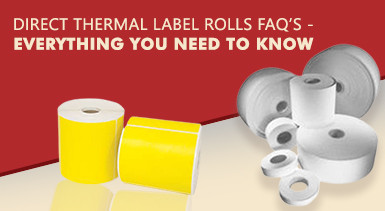Posted by Label Warehouse on 20th Oct 2023
Direct Thermal Label Rolls FAQ’s: Everything You Need to Know
How to Identify Direct Thermal Label Rolls
To determine if the labels you've chosen are direct thermal label rolls, you can follow these steps:
Check Label Material
Direct thermal labels are typically made of special paper that is coated with a heat-sensitive layer. They do not require ink or ribbons for printing. Examine the label material closely; if it has a smooth, glossy surface, it's likely direct thermal.
Label Appearance
Direct thermal labels often have a single-layer design. If you notice that the label has a distinct white surface with no visible layers, it's a sign that it's direct thermal. Labels that require thermal transfer printing typically have a multi-layered appearance.
Print Technology
Direct thermal printer label are designed for use with direct thermal printers, which apply heat to the label to create an image. Verify that you are using a direct thermal printer to ensure compatibility with direct thermal labels.
Smudge Test
Rub your finger or a piece of paper across the label's surface. Direct thermal labels are sensitive to heat and will produce smudges or marks when subjected to friction or heat. If the label smudges easily, it's likely a direct thermal label.
Heat Sensitivity
Direct thermal labels are heat-sensitive, meaning that they will gradually darken when exposed to heat or direct sunlight over time. Test a small portion of the label by applying gentle heat (e.g., with a hair dryer) to see if it darkens. Thermal transfer labels will not respond to heat in the same way.
Label Specifications
Review the label specifications provided by the manufacturer or supplier. Direct thermal labels are usually labelled as such in their product descriptions. Look for terms like "direct thermal," "DT," or "thermal sensitive."
Consult with the Supplier
If you're still uncertain, contact the supplier or manufacturer from whom you purchased the labels. They can confirm whether the labels are direct thermal or provide guidance on how to identify them.
By following these steps and paying attention to the label material, appearance, sensitivity to heat, and compatibility with direct thermal printers, you can confidently determine whether the labels you have chosen are indeed direct thermal label rolls.
How to Ensure the Longevity and Legibility of Direct Thermal Label Rolls
To ensure the longevity and legibility of direct thermal label rolls over time, consider the following best practices:
Choose High-Quality Labels
Start by selecting high-quality direct thermal labels. Opt for labels that are manufactured using premium materials and coatings. These labels are more likely to withstand the test of time and maintain their legibility.
Store Labels Properly
Store your label rolls in a cool, dry place away from direct sunlight and extreme temperature fluctuations. Heat and humidity can adversely affect the sensitivity of direct thermal labels and lead to premature fading or darkening.
Protect from UV Exposure
Direct thermal labels are sensitive to UV (ultraviolet) light. Whenever possible, avoid exposing labelled items to direct sunlight or strong UV sources to prevent label fading over time.
Use a Quality Direct Thermal Printer
Ensure that you are using a high-quality direct thermal printer designed for your specific label rolls. Cheap or incompatible printers can result in poor print quality and reduced longevity. Regularly clean and maintain your printer to prevent dust and debris build-up.
Adjust Print Density
Most direct thermal printers allow you to adjust print density. Experiment with the settings to find the right balance between a clear, dark print and label longevity. Avoid setting the print density unnecessarily high, as it can accelerate label fading.
Avoid Abrasion and Scratching
Handle labelled items with care to prevent abrasion and scratching of the labels. When affixing labels to surfaces, ensure that they are fully adhered to prevent edges from lifting, which can lead to damage over time.
Laminate Labels (if necessary)
For labels that need to endure harsh conditions or handling, consider using a label laminator or applying a clear label protector. Laminating can provide an extra layer of protection against abrasion, moisture, and fading.
Regularly Inspect Labels
Periodically inspect labelled items for signs of fading or damage. Replace labels that have become illegible or worn out promptly to maintain accuracy and readability.
Use Quality Label Adhesives
Labels with strong, durable adhesives will stay in place longer. Ensure that the adhesive used on your labels is appropriate for the intended application and environment.
Keep Records
Maintain records of label rolls, printer settings, and environmental conditions to track label performance over time. This information can help you identify any issues and make necessary adjustments.
By following these guidelines, you can maximise the longevity and legibility of your direct thermal label rolls, ensuring that they remain effective and readable for an extended period.
Are Direct Thermal Label Rolls Safe for Use in Sunlight?
Using direct thermal label rolls in areas exposed to direct sunlight can be problematic and is generally not recommended. Direct thermal labels are sensitive to UV (ultraviolet) light, and prolonged exposure to sunlight can lead to several issues:
- Fading: Direct thermal labels will gradually fade when exposed to direct sunlight. This fading can render the labels illegible and compromise the information they convey.
- Reduced Legibility: Labels that have faded due to sun exposure may become difficult to read, leading to errors or confusion in labelling applications.
- Shortened Lifespan: Sunlight can accelerate the thermal paper's chemical reaction, causing the labels to darken or turn black prematurely. This shortens the lifespan of the labels and reduces their overall effectiveness.
- Inaccurate Information: In situations where accurate information is critical, such as in logistics, healthcare, or product labelling, using labels that fade or become illegible due to sunlight can have serious consequences.
To mitigate these issues, consider the following steps:
- Choose UV-Resistant Labels: If labels will be exposed to sunlight, opt for UV-resistant labels specifically designed to withstand UV radiation. These labels have coatings or materials that protect against fading and deterioration caused by sunlight.
- Label Protection: Apply a clear label protector or laminate over the direct thermal labels to create a barrier against UV exposure. This added layer can help preserve the labels' legibility.
- Limit Exposure: If possible, minimise the time that labelled items spend in direct sunlight. Store or transport items in shaded or covered areas when necessary.
- Regular Inspection: Conduct regular inspections of labels exposed to sunlight to check for signs of fading or damage. Replace labels that show signs of deterioration promptly.
While it's generally not safe to use standard direct thermal label rolls in areas exposed to direct sunlight due to their sensitivity to UV light, you can take precautions such as choosing UV-resistant labels or adding protective layers to mitigate the negative effects of sunlight and ensure the longevity and legibility of your labels in such environments.
Can Direct Thermal Label Rolls Be Used for Specialized Applications?
Direct thermal label rolls can indeed be used for various specialised applications, including barcoding, RFID (Radio-Frequency Identification), and security labelling, but the suitability of direct thermal labels for these purposes may depend on specific requirements and conditions. Here's a breakdown of each application:
Barcoding
Direct thermal labels are commonly used for barcoding applications, especially in situations where the labels won't be exposed to harsh environmental conditions or extended periods of sunlight. They are well-suited for applications like retail price tags, shipping labels, and inventory management.However, it's important to consider factors such as label size, print density, and the expected lifespan of the labelled items. If the barcodes need to remain readable for a long time or be exposed to extreme conditions, you might opt for thermal transfer labels, which are more durable and resistant to fading and abrasion.
RFID Labelling
RFID technology involves embedding RFID chips and antennas within labels to enable wireless data transmission and tracking. While direct thermal labels can be used for this purpose, RFID labelling typically requires specialised RFID labels designed to accommodate the RFID components. These labels are often more complex and include an RFID inlay, which may not be compatible with standard direct thermal labels.It's advisable to use dedicated RFID labels for RFID applications to ensure proper functionality and data transmission.
Security Labelling
Thermal labels can be used for security labelling, such as for tamper-evident seals, authentication labels, or asset tracking where security features are integrated into the label design. Many direct thermal labels are available with security features like holograms, watermarks, or void patterns that deter tampering and counterfeiting.The suitability of direct thermal labels for security applications will depend on the level of security required and the specific features needed. Some applications may require more specialised security labelling solutions.
Direct thermal label rolls can be used for specialised applications like barcoding and security labelling, but their appropriateness depends on the specific requirements of each application. It's essential to assess factors such as durability, print quality, and environmental conditions when choosing labels for specialised purposes. For applications like RFID labelling, dedicated RFID labels are typically recommended for optimal performance.
Why Choose Label Warehouse for Direct Thermal Label Rolls?
- Quality Assurance: Label Warehouse provides high-quality direct thermal labels that ensure clear, reliable printing for your labelling needs.
- Wide Selection: They offer a wide range of label sizes and types to meet diverse requirements, from shipping labels to barcode labels.
- Affordability: Label Warehouse offers competitive prices, helping you save on label costs without compromising quality.
- Reliable Service: Their dependable customer service and fast shipping ensure you get your labels on time, reducing downtime.
- Trusted Reputation: With a strong track record and positive customer feedback, Label Warehouse is a trusted supplier in the labelling industry.

